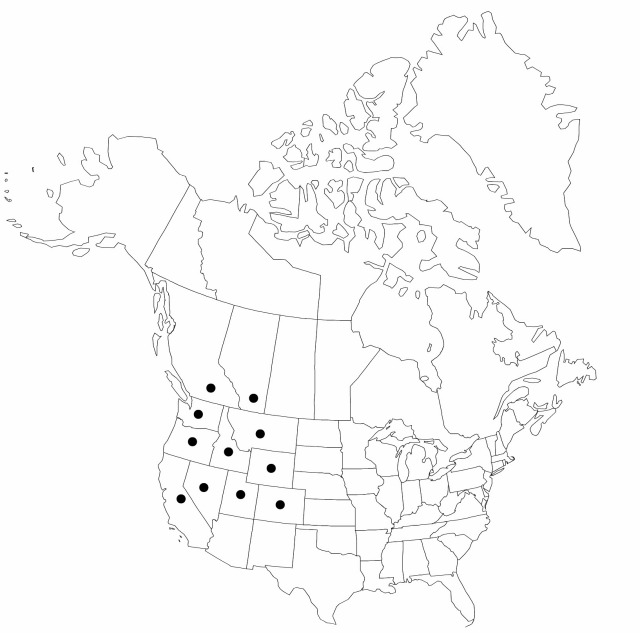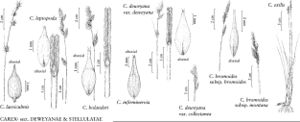Difference between revisions of "Carex infirminervia"
Novon 12: 528, fig. 7. 2002.
FNA>Volume Importer |
imported>Volume Importer |
||
| (3 intermediate revisions by 2 users not shown) | |||
| Line 32: | Line 32: | ||
-->{{#Taxon: | -->{{#Taxon: | ||
name=Carex infirminervia | name=Carex infirminervia | ||
| − | |||
|authority=Naczi | |authority=Naczi | ||
|rank=species | |rank=species | ||
| Line 47: | Line 46: | ||
|publication year=2002 | |publication year=2002 | ||
|special status= | |special status= | ||
| − | |source xml=https:// | + | |source xml=https://bitbucket.org/aafc-mbb/fna-data-curation/src/2e0870ddd59836b60bcf96646a41e87ea5a5943a/coarse_grained_fna_xml/V23/V23_572.xml |
|genus=Carex | |genus=Carex | ||
|section=Carex sect. Deweyanae | |section=Carex sect. Deweyanae | ||
Latest revision as of 20:41, 5 November 2020
Plants densely cespitose. Culms 10–83 cm × 0.8–1.3 mm, papillose at mid height. Leaves: ligule of distal leaf (2.1–)2.6–6.8 mm; blades 1.4–3.8 mm wide, widest blade 2.3–3.8 mm wide. Inflorescences 27–68 mm, proximalmost 2 spikes overalapping or separate; proximal internode 7.3–28 mm; proximal bract 11–61 mm; spikes (4–)5–6(–7), usually gynecandrous, sometimes pistillate or staminate; proximal spike usually with 1–3 staminate and 11–22 pistillate flowers, longest per plant with 12–22 pistillate flowers, 9.7–18 × 3.7–6.6 mm, longest per plant 12–18 mm; terminal spike usually with 1–3 staminate and 14–21 pistillate flowers, sessile or on peduncle to 1.8 mm, 9.6–16 × 3.4–6.2 mm. Pistillate scales whitish to castaneous, with green midrib, 2.9–4.4 mm, body 2.9–3.8 × 1.4–1.8 mm, apex acuminate to short-awned, awn to 1.1 mm. Staminate scales with whitish to castaneous margins, 3.1–4.3 × 1–1.5 mm, apex acute to short-awned. Anthers 1.3–1.8 mm. Perigynia erect to appressed-erect, green to brown, veinless or weakly 1–3(–4)-veined abaxially, veinless adaxially, narrowly lanceolate in outline, 3.7–5.3 × 1.1–1.3(–1.4) mm, 3.2–3.9(–4.2) times as long as wide, apex gradually tapering; beak 1.5–2.2 mm, 39–49% of total perigynium, margins denticulate for distal 49–60% of length of perigynium, apex entire or bidentulate, teeth 0–0.2(–0.4) mm, 0–8% of length of perigynium. Stigmas 1.8–2.5 mm. Achenes 1.6–2.2 × 1.1–1.3 mm, 1.5–1.8 times as long as wide.
Phenology: Fruiting (late spring–)summer.
Habitat: Mesic to dry-mesic deciduous and deciduous-coniferous forests, often on slopes above streams, occasionally in open habitats such as grassy slopes
Elevation: 600–2500 m
Distribution

Alta., B.C., Calif., Colo., Idaho, Mont., Nev., Oreg., Utah, Wash., Wyo.
Discussion
The recently described Carex infirminervia is quite scattered and uncommon throughout its range. Occasionally, plants of C. infirminervia grow with or very close to plants of C. bolanderi, C. deweyana, and C. leptopoda. Past failure to recognize C. infirminervia led to confusion among these taxa and is likely responsible for the desiscion by many authors of recent floristic treatments to lump C. bolanderi, C. deweyana, and C. leptopoda.
Selected References
None.
